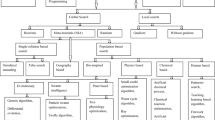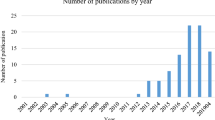Abstract
The tool planning problem is to determine how many tools should be allocated to each tool group to meet some objectives. Recent studies aim to solve the problem for the cases of uncertain demand. Yet, most of them do not involve cycle time constraints. Cycle time, a key performance index in particular in semiconductor foundry, should not be ignored. The uncertain demand is modeled as a collection of scenarios. Each scenario, with an occurrence probability, represents the aggregate demand volume under a given product mix ratio. A genetic algorithm embedded with a queuing analysis is developed to solve the problem. Experiments indicate that the proposed solution outperforms that obtained by considering only a particular scenario.
Similar content being viewed by others
References
Chou Y-C, You R-C (2001) A resource portfolio planning methodology for semiconductor wafer manufacturing. Int J Adv Manuf Technol 18:12–19
Witte JD (1996) Using static modeling techniques in semiconductor manufacturing. IEEE/SEMI Advanced Semiconductor Manufacturing Conference, Cambridge, MA, pp 31–35
Grewal NS, Bruska AC, Wulf TM, Robinson JK (1998) Integrating targeted cycle-time reduction into the capital planning process. Proceedings of the 1998 Winter Simulation Conference, Washington, D.C., pp 1005–1010
Mollaghsemi M, Evans GW (1994) Multicriteria design of manufacturing systems through simulation optimization. IEEE Trans Syst Man Cybern 24(8):1407–1411
Chen LH, Chen YH (1996) A design procedure for a robust job shop manufacturing system under a constraint using computer simulation experiments. Comput Ind Eng 30(1):1–12
Whitt W (1983) The queuing network analyzer. Bell Syst Tech J 62(8):2779–2815
Suri R, Hildebrant RR (1984) Modeling flexible manufacturing systems using mean-value analysis. J Manuf Syst 3(1):27–37
Buzacott JA, Yao DD (1986) Flexible manufacturing systems: a review of analytical models. Manage Sci 3:890–905
Kouvelis P, Tirupati D (1991) Approximate performance modeling and decision making for manufacturing systems: a queueing network optimization framework. J Intell Manuf 2:107–134
Connors DP, Feigin GE, Yao D (1996) A queueing network model for semiconductor manufacturing. IEEE Trans Semicond Manuf 9(3):412–427
Yoneda K, Wada I, Haruki K (1992) Job shop configuration with queueing networks and simulated annealing. Proceedings of the IEEE International Conference on Systems Engineering, Kobe, Japan, 1719 Sept 1992, pp 407–410
Bretthauer KM (1996) Capacity planning in manufacturing and computer networks. Eur J Oper Res 91:386–394
Hopp WJ (2002) Using an optimized queueing network model to support wafer design. IIE Trans 34:119–130
Bard JF (1999) An optimization approach to capacity expansion in semiconductor manufacturing facilities. Int J Prod Res 37:3359–3382
Chou Y-C (1999) Configuration design of complex integrated manufacturing systems. Int J Adv Manuf Technol 15:907–913
Chou Y-C, Wu C-S (2002) Economic analysis and optimization of tool portfolio in semiconductor manufacturing. IEEE Trans Semicond Manuf 15(4):447–453
Swaminathan JM (2000) Tool capacity planning for semiconductor fabrication facilities under demand uncertainty. Eur Oper Res 120:545–558
Swaminathan JM (2002) Tool procurement planning for wafer fabrication facilities: a scenario-based approach. IIE Trans 34:145–155
Barahona F, Bermon S, Gunluk O, Hood S (2001) Robust Capacity Planning in Semiconductor Manufacturing. IBM report RC22196. Available online in PostScript format form http://www.optimization-online.org/DB_HTML/2001/10/379.html
Hood SJ, Bermon S, Barahona F (2003) Capacity Planning Under Demand Uncertainty for Semiconductor Manufacturing. IEEE Transactions on Semiconductor Manufacturing 16(2):273–280
Bethke AD (1981) Genetic algorithm as function optimizers. Dissertation, Dept of Computer and Communication Sciences, University of Michigan
Gen M, Cheng R (2000) Genetic algorithms and engineering optimization. Wiley, New York, pp 1–2
Levitin G (2000) Multistate series-parallel system expansion-scheduling subject to availability constraints. IEEE Trans Reliab 49(1):71–79
Winston PH (1992) Artificial intelligence. Addison-Wesley, Boston pp 520–527
Author information
Authors and Affiliations
Corresponding author
Rights and permissions
About this article
Cite this article
Wu, MC., Hsiung, Y. & Hsu, HM. A tool planning approach considering cycle time constraints and demand uncertainty. Int J Adv Manuf Technol 26, 565–571 (2005). https://doi.org/10.1007/s00170-003-2030-2
Received:
Accepted:
Published:
Issue Date:
DOI: https://doi.org/10.1007/s00170-003-2030-2




